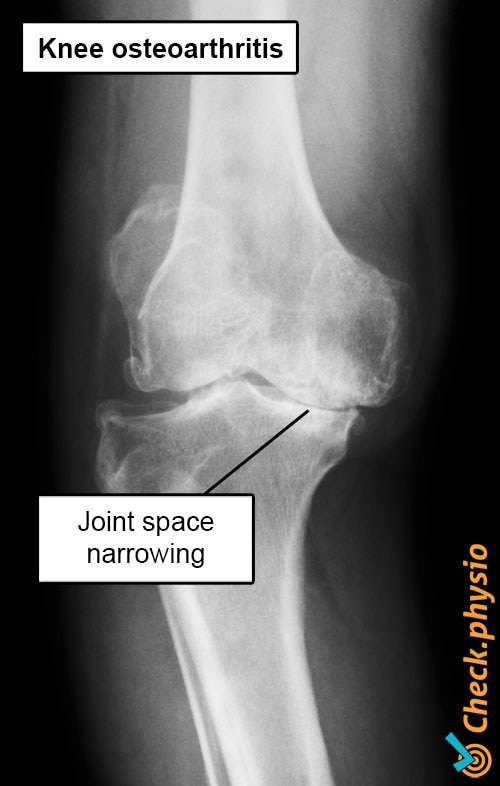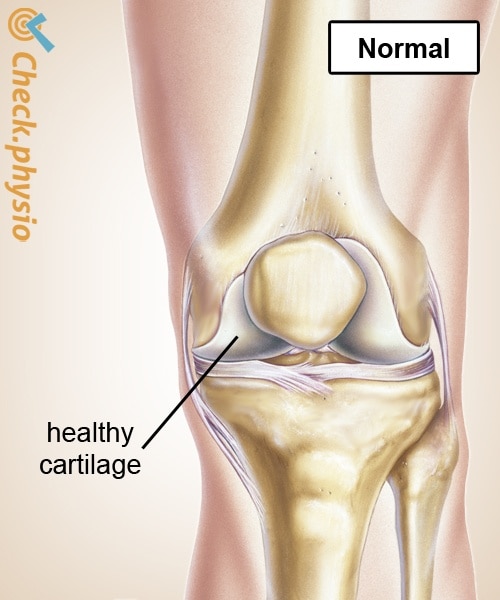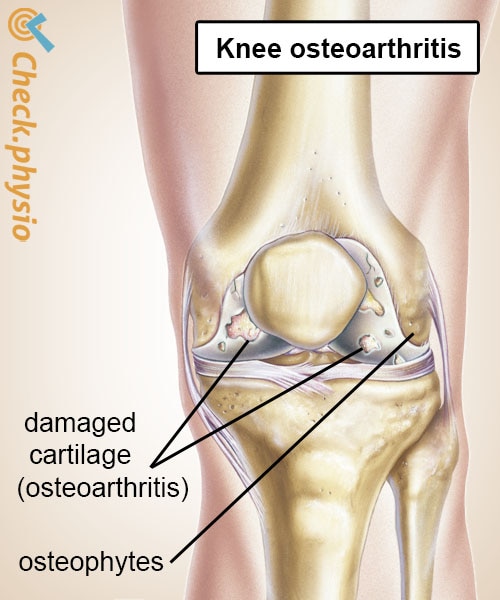Osteoarthritis of the knee
Knee osteoarthritis / gonarthrosis / wear-and-tear of the knee joint
Osteoarthritis of the knee is a common form of osteoarthritis. It is commonly known as osteoarthritis of the knee and specialists also refer to it as gonarthrosis.

Osteoarthritis of the knee mainly affects people over the age of fifty.
Description of condition
A thin layer of cartilage covers all joint surfaces. This acts as a shock absorber and ensures easy sliding of individual bone components within the joint. Osteoarthritis is associated with deteriorating quality of the cartilage. This causes the joint to move less smoothly and shocks to be absorbed less effectively. Loss of cartilage can result in chronic knee pain.
Once the cartilage is gone, bone-to-bone contact may occur in the joint. This is painful and makes the joint less mobile. The body responds by forming osteophytes. This means that abnormal bony growths occur along the edges of the joint. This is the body's repair response to combat the effects of osteoarthritis. By making the joint wider, it distributes the pressure over a greater surface area.
Cause and history
The patient is usually aged over 50. The symptoms develop gradually as a result of aging. The quality of the cartilage decreases over time, and wear-and-tear occurs. This is a natural process. Almost everyone over the age of 75 has osteoarthritis in one or more joints.
Osteoarthritis of the knee may also occur at a younger age. For example, the cartilage may become damaged in an accident. Symptoms can also develop as a result of abnormalities within the joint. Injuries to the meniscus or the cruciate ligaments, or an abnormal stance can result in osteoarthritis, because the cartilage is strained for an extended period of time.
Signs & symptoms
People with knee osteoarthritis usually experience pain and stiffness in the knee joint.
Typical symptoms include:
- Painful knees, particularly when moving around.
- Morning stiffness. This means that the symptoms occur mainly in the morning or after an extended period of inactivity. The person needs to "get moving" before the symptoms ease up.
- Crepitations (a cracking sound or sensation in the knee when moving).
- Swelling.
- Widening of the knee joint.
- Decreased mobility in knee movements. Particularly bending the knee (crouching).
- Locking symptoms (the joint locks suddenly when moving).
Not all of the symptoms are present all the time and people may experience periods with more symptoms or fewer symptoms. The entire joint is usually sensitive/painful. The affected part of the knee may be the most painful.
Diagnosis
The joint space is narrower on an X-ray. Any osteophyte formation will also be visible. X-rays will only be performed if the physical examination does not provide a reliable diagnosis, or if the result of the X-ray will determine the treatment.
Treatment
Wear-and-tear in the cartilage cannot be reversed. Once it's gone, it's gone. It is possible to keep the cartilage as healthy as possible by getting regular doses of gentle exercise. Things like walking or cycling. We will explain below about why it is important to keep moving.
Cartilage acts like a sponge. When weight is placed on it, it compresses and the waste products are removed. When the pressure is released, the cartilage sucks in nutrients. This sponge action therefore ensures an ideal environment for the cartilage. This explains why complete rest is bad for the cartilage; the sponge effect does not occur, resulting in reduced circulation of waste products and nutrients.
An exercise program for the knee, under the supervision of a physiotherapist, can be created to combat the effects of osteoarthritis. In addition, various techniques can be applied to keep the knee as mobile and pain-free as possible.
If conservative treatment does not result in improvement, then surgical intervention may be considered. A number of procedures are possible. A knee replacement (knee prosthesis) is possible for severe, increasing symptoms. Surgeons are reluctant to perform joint replacements in patients under 50, because the risk is then higher that another knee replacement will be required at a later date.
Exercises
With osteoarthritis of the knee it is essential to keep moving, but carefully. Take a look here at the online exercise program with exercises for osteoarthritis of the knee.
You can check your symptoms using the online physiotherapy check or make an appointment with a physiotherapy practice in your locality.


References
Nugteren, K. van & Winkel, D. (2007). Onderzoek en behandeling van de heup. Houten: Bohn Stafleu van Loghum.
Nugteren, K. van & Winkel, D. (2009). Onderzoek en behandeling van artrose en artritis. Houten: Bohn Stafleu van Loghum.
Verhaar, J.A.N. & Linden, A.J. van der (2005). Orthopedie. Houten: Bohn Stafleu van Loghum.




